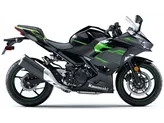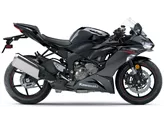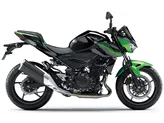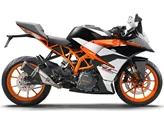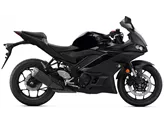Yamaha YZF-R6 2017 vs. Kawasaki Ninja 400 2018

Yamaha YZF-R6 2017

Kawasaki Ninja 400 2018
Overview - Yamaha YZF-R6 2017 vs Kawasaki Ninja 400 2018
The Yamaha YZF-R6 2017 and the Kawasaki Ninja 400 2018 are both popular supersport motorcycles that offer different features and performance capabilities.
Starting with the engine and drivetrain, the Yamaha YZF-R6 2017 is equipped with a 599cc, 4-cylinder engine that delivers a powerful 124 horsepower and 65.7 Nm of torque. It has a bore of 67mm and a stroke of 42.5mm, with a compression ratio of 13. On the other hand, the Kawasaki Ninja 400 2018 has a smaller 399cc, 2-cylinder engine that produces 45 horsepower and 38 Nm of torque. It has a larger bore of 70mm and stroke of 51.8mm, with a compression ratio of 11.5.
In terms of suspension, the Yamaha YZF-R6 2017 features an upside-down telescopic fork at the front, providing excellent stability and control. The Kawasaki Ninja 400 2018, on the other hand, has a telescopic fork at the front, which also offers good suspension performance.

Yamaha YZF-R6 2017
When it comes to the chassis, the Yamaha YZF-R6 2017 has an aluminum frame, specifically a Deltabox frame, which is known for its rigidity and lightweight construction. This contributes to the bike's precise handling and agility. The Kawasaki Ninja 400 2018, on the other hand, has a steel frame, specifically a tubular frame, which provides a balance between strength and weight. This allows for effortless handling and maneuverability.
In terms of braking, the Yamaha YZF-R6 2017 is equipped with double disk brakes at the front, providing strong and direct stopping power. The Kawasaki Ninja 400 2018, on the other hand, has a single disk brake at the front, which also offers good braking performance.
In terms of dimensions and weights, both motorcycles have 17-inch wheels. The Yamaha YZF-R6 2017 has a front tire width of 120mm and a rear tire width of 180mm. The Kawasaki Ninja 400 2018 has a front tire width of 110mm and a rear tire width of 150mm. The wheelbase of both bikes is similar, with the Yamaha YZF-R6 2017 having a slightly longer wheelbase of 1375mm compared to the Kawasaki Ninja 400 2018's 1370mm. The seat height of the Yamaha YZF-R6 2017 is 850mm, while the Kawasaki Ninja 400 2018 has a lower seat height of 785mm. Both motorcycles have a fuel tank capacity of 14 liters.

Kawasaki Ninja 400 2018
In terms of strengths, the Yamaha YZF-R6 2017 offers strong and direct brakes, sharp looks, an automatic gearshift, good wind protection, precise handling, and high transparency. The Kawasaki Ninja 400 2018, on the other hand, has a chassis suitable for sporty use, low weight for effortless handling, an engine with smooth response, a relaxed and confidence-enhancing seating position, and LED headlights.
However, the Yamaha YZF-R6 2017 also has some weaknesses, including a radical seating position that may not be suitable for touring, a standard power output of only 118.4 horsepower, and upgrade costs that can be expensive. The Kawasaki Ninja 400 2018 has its own weaknesses, such as brake and clutch levers that are not adjustable and an issue with loud wind noise for riders over 180cm tall.
In conclusion, the Yamaha YZF-R6 2017 and the Kawasaki Ninja 400 2018 are both impressive supersport motorcycles with their own unique features and performance capabilities. The Yamaha YZF-R6 2017 offers more power and a sportier seating position, while the Kawasaki Ninja 400 2018 provides a lightweight chassis and a more relaxed riding position. Ultimately, the choice between the two will depend on the rider's preferences and intended use of the motorcycle.
Technical Specifications Yamaha YZF-R6 2017 compared to Kawasaki Ninja 400 2018
Pros and Cons in comparison
Pros and Cons in comparison
Yamaha YZF-R6 2017

2017 Yamaha R6, türünün en iyilerinden biri ve muhtemelen sonuncusu olan, görsel ve dinamik açidan radikal bir süperspor motosiklettir. EURO4 standardi, titanyum supaplara sahip 599 cc sirali dört silindire 2007/2008 modeline kiyasla tam 11 hp güç kaybettiriyor. Ancak Yamaha'nin standart performansi önemsemeyen hobi, amatör ve profesyonel yarisçilari hedefledigi açiktir. R6, 50'den fazla aksesuar ile ihtiyaçlara ve bütçeye göre yükseltilebilir. Ancak, herkes bunun oldukça pahali olabileceginin farkinda olmalidir.
Kawasaki Ninja 400 2018

Ninja 400, süperspor dünyasina mükemmel bir giris olarak özetlenebilir. A2 ile daha fazla güç mümkün degil, görünüsü çok daha fazla gücü çagristiriyor, aracin kullanimi kolay, her açidan affedici ve yine de gerçekten sportif bir sürüs tarzina izin veriyor. Çesitli 250 metreküp makinelerde güç eksikligi konusunda hakli endiseleri olan herkesin artik bahanesi kalmadi. Ninja 400, iyi ki buradasin!
Price Comparison Avarage Market Price Yamaha YZF-R6 vs Kawasaki Ninja 400
There are a few key differences between a Yamaha YZF-R6 2017 and a Kawasaki Ninja 400 2018. It takes less time to sell a Kawasaki Ninja 400 with 105 days compared to 136 days for the Yamaha YZF-R6. Since model year 2005 1000PS.de editors have written 33 reviews for the Yamaha YZF-R6 and 9 reviews for the Kawasaki Ninja 400 since model year 2018. The first review for the Yamaha YZF-R6 was published on 10/17/2002 and now has more than 3,600 views. This compares to more than 44,300 views for the first review on Kawasaki Ninja 400 published on 11/22/2017.




